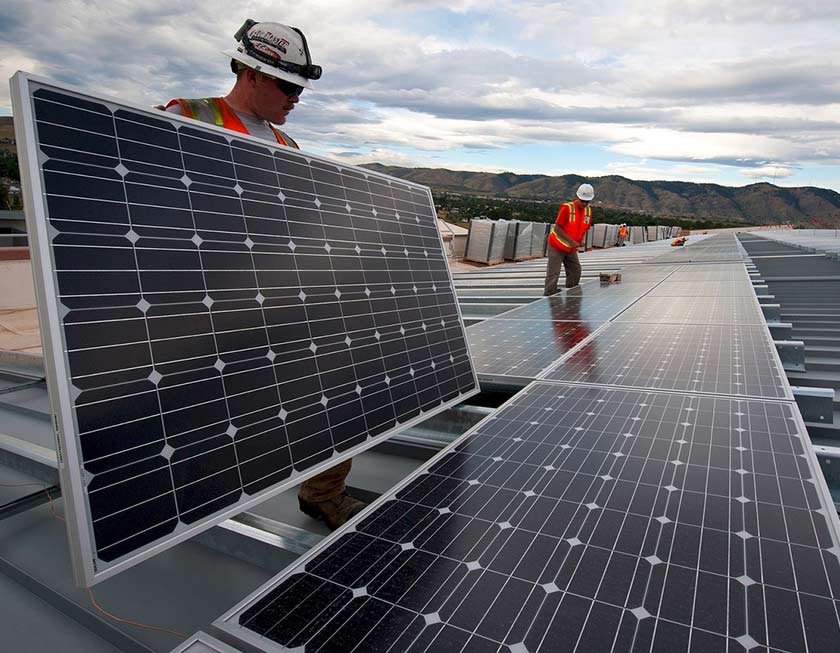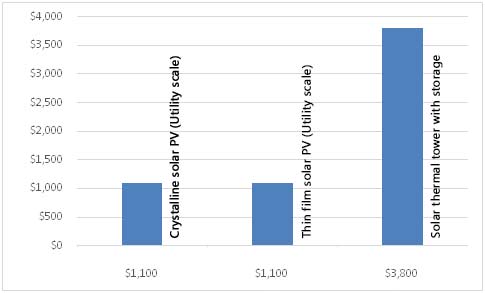3.5 Concentrating Solar or Solar Photovoltaics?

Advantages of solar photovoltaics over concentrating solar power
In the previous article, we discussed advantages of concentrating solar power. This article mainly focuses on the advantages of solar photovoltaics.
Energy conversion efficiency: As we discussed in a previous article, the energy conversion efficiency in concentrated solar thermal power depends on the technology. Parabolic trough configuration is currently considered to be the most advantageous concentrating solar technology and thus is the most popular concentrating solar technology which, however, still cannot operate with an efficiency higher than 15%. The typical system efficiency is still in the range of 10-15%. When it comes to conversion efficiency, single crystalline silicon solar cells are now more efficient than ever before offering impressive conversion efficiencies ranging from 18-22%.
In particular, recent years have seen a boom in the crystalline silicon solar cell manufacturing industry which has fueled a huge competition among government and private research institutions to break the existing conversion efficiency. For example, LONGi Solar, a leading manufacturer of high-efficient crystalline solar cells/ modules has broken their own efficiency record to set a new efficiency record of 23.6% for nanocrystalline PERC (Passivated emitter rear cell) solar cells. [1]. Heterojunction back-contact (HBC) solar cells have achieved a striking efficiency of 26.6%.
High efficiency means high energy yield per unit area. So, solar photovoltaics are more space efficient than the parabolic trough systems which are the most realistic concentrating solar technology.
Space efficiency: Space efficiency is primarily determined by the energy conversion efficiency. The higher the energy conversion efficiency the greater the space efficiency of the system. It has been estimated that the parabolic trough systems require 91000 m2 to generate 3855 MW h of electricity while solar photovoltaics (with single axis solar tracking) generates the same amount of electricity 62, 346 m2 (during the first year) [2].
Initial investment needed per kW / Payback time:
Payback time, one of the most important aspects that attracts investors’ attention is largely determined by the overall system efficiency and the initial investment needed.
- The greater the energy conversion efficiency the shorter the payback time.
- Higher the initial investment the longer the payback time.
Following chart illustrates the capital investment needed per kW by different types of solar energy technologies. It can be seen that solar photovoltaics require less amount of capital investment compared to solar thermal tower technology (Note that the value of energy storage capacity offered by the solar thermal tower systems with energy storage is not taken into consideration in this discussion).
Thin film solar cells require the same amount of capital investment as crystalline solar cells but are less space-efficient than their crystalline counterpart (We will discuss later).

Figure: Capital cost per kW by technology (Lowest scenario) [3]
Unlike concentrating solar technology, cost of solar photovoltaics has been substantially falling in recent years while the efficiency has been steadily increasing. To illustrate, the cost of photovoltaic (per Wattage) decreased from $ 1.3 (2011) to $ 0.5 (2014) [4].
So, it is clear that solar photovoltaics offer the shortest payback time as they are more efficient than the concentrating solar power but require less amount of capital investment.
Solar photovoltaics are born with several other powerful benefits. We will discuss them in the next article.
References
[1] Rodriguez, J., Wang, E. C., Chen, N., Ho, J. W., Li, M., Buatis, J. K., and Wong, J. (2018). Towards 22% efficient screen-printed bifacial n-type silicon solar cells. Solar Energy Materials and Solar Cells, 187, 91-96.
[2] Desideri, U., Zepparelli, F., Morettini, V., and Garroni, E. (2013). Comparative analysis of concentrating solar power and photovoltaic technologies: technical and environmental evaluations. Applied energy, 102, 765-784.
[3] Lazard, N. (2017). Lazard’s Levelized Cost of Energy Analysis–Version 11.0.
[4] Kabir, E., Kumar, P., Kumar, S., Adelodun, A. A., and Kim, K. H. (2018). Solar energy: Potential and future prospects. Renewable and Sustainable Energy Reviews, 82, 894-900.
